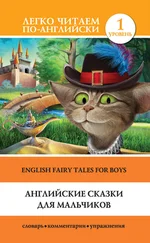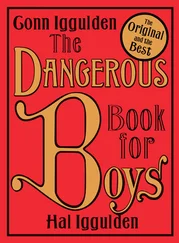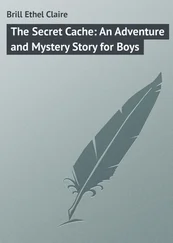Robert Robert - Scouting for Boys
Здесь есть возможность читать онлайн «Robert Robert - Scouting for Boys» весь текст электронной книги совершенно бесплатно (целиком полную версию без сокращений). В некоторых случаях можно слушать аудио, скачать через торрент в формате fb2 и присутствует краткое содержание. Жанр: Старинная литература, und. Описание произведения, (предисловие) а так же отзывы посетителей доступны на портале библиотеки ЛибКат.
- Название:Scouting for Boys
- Автор:
- Жанр:
- Год:неизвестен
- ISBN:нет данных
- Рейтинг книги:3 / 5. Голосов: 1
-
Избранное:Добавить в избранное
- Отзывы:
-
Ваша оценка:
- 60
- 1
- 2
- 3
- 4
- 5
Scouting for Boys: краткое содержание, описание и аннотация
Предлагаем к чтению аннотацию, описание, краткое содержание или предисловие (зависит от того, что написал сам автор книги «Scouting for Boys»). Если вы не нашли необходимую информацию о книге — напишите в комментариях, мы постараемся отыскать её.
Scouting for Boys — читать онлайн бесплатно полную книгу (весь текст) целиком
Ниже представлен текст книги, разбитый по страницам. Система сохранения места последней прочитанной страницы, позволяет с удобством читать онлайн бесплатно книгу «Scouting for Boys», без необходимости каждый раз заново искать на чём Вы остановились. Поставьте закладку, и сможете в любой момент перейти на страницу, на которой закончили чтение.
Интервал:
Закладка:
Clearing the Ground
Before lighting your fire, remember always to do as every backwoodsman does, and that is to remove all grass, dry leaves, bracken, heather, round the spot, to prevent the fire from spreading to the surrounding grass or bush. Many bad bush fires have been caused by young tenderfoots fooling about with blazes which they imagined to be camp fires. Where there is danger of a grass fire, have branches or old sacks ready with which you can beat it out.
Scouts should always be on the look-out to beat out a bush fire that had been accidentally started at any time, as a Good Turn to the owner of the land or to people who may have herds and crops in danger.
Laying the Fire
It is no use to learn how to light a fire by hearsay. The only way is to pay attention to the instructions given you, and then practise laying and lighting a fire yourself.
In the book called Two Little Savages, instructions for laying a fire are given in the following rhyme:—
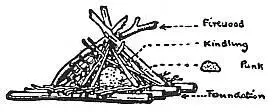
“First a curl of birch bark as dry as it can be, Then some twigs of soft wood dead from off a tree, Last of all some pine knots to make a kettle foam, And there’s a fire to make you think you’re sitting right at home.”
With a fire built this way, one match may be all you will need.
Remember the usual fault of a beginner is to try to make too big a fire. You will never see a backwoodsman do that— he uses the smallest possible amount of wood for his fire.
First collect your firewood. Green, fresh-cut wood is no good, nor is dead wood that has lain long on the ground. Get permission to break dead branches off trees for it.
To make your fire, you put a few sticks flat on the ground, especially if the ground be damp. On this flooring lay your “punk”—that is, shavings, splinters, or any other material that will easily catch fire from your match.
On this you pile, in pyramid fashion, thin twigs, splinters, and slithers of dry wood, leaning on the “punk” and against each other. These are called kindling.
A good kind of kindling can easily be made by slitting a stick into several slices or shavings, as shown. This is called a firestick. If stood up, with the shavings downwards towards the ground, it quickly catches light and flares up.
A few stouter sticks are added over the kindling to make the fire.
Lighting the Fire
Set light to all this, putting your match under the bottom of the “punk”.
TOMMY THE TENDERFOOT No. 6 - TOMMY BUILDS A FIRE
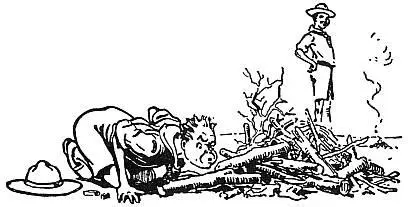
On lighting of fires he sets everyone right, But his own little bonfire refused to ignite.
When the wood has really got on fire, add more and larger sticks, and finally logs.

“Firesticks” whittled from dr y wood make good fire starters.
A Tenderfoot after lighting his fire will blow out his match and throw it on the ground. A backwoodsman will break the match in half before throwing it away. Why? Because if the match is not really out and is still smouldering it will tell him so—by burning his hand.
Several Kinds of Fires
A great thing for a cooking fire is to get a good pile of red-hot wood embers, and if you use three large fogs, they shouldbe placed on the ground, star-shaped, like the spokes of a wheel, with their ends centred in the fire. A fire made in this way need never go out, for as the logs burn away you keep pushing them towards the centre of the fire, always making fresh red-hot embers there. This makes a fire which gives very little flame or smoke.
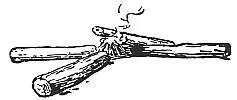
The “star fire” consists of logs placed like the spokes of a wheel.
If you want to keep a fire flaming during the night for light or to warm you, use the star fire with one long log
reaching to your hand, so that you can push it in from time to time to the centre without trouble of getting up to stoke the fire.
To keep your fire smouldering overnight, cover it over with a heap of ashes. It will then be ready for early use in the morning, when you can easily blow it into a glow.
Here is a way they use in North America for making a fire for heating your tent:
Drive two stout stakes into the ground about four feet apart, both leaning a bit backwards. Cut down a young tree with a trunk some six inches thick; chop it into four-foot lengths. Lay three or more logs, one on top of another, leaning against the upright stakes. This “reflector” forms the back of your fireplace. Two short logs are then laid as fire-dogs, with a log across them as front
bar of the fire. Inside this “grate” you build a pyramid-shaped fire, which then gives out great heat. The “grate” must, of course, be built so that it faces the wind.
Putting Out the Fire
A Scout is very careful about fires. When he uses one he sees that it is well out before he leaves the place. The fire should be doused with water and earth,
and stamped down well, so that there is not a spark left that might later start a fire. Finally the original turf—which was
put on one side before you made the fire—is put back so that hardly a trace is left.
Tongs are useful about a camp fire. They can be made from
a rod of beech or other tough wood, about four feet long and one inch thick. Shave it away in the middle to about half its
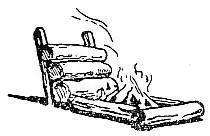
The “reflector fire” is used in North America for heating your tent, especially when you go camping in the winter time.
proper thickness; put this part into the hot embers of the fire for a few moments, and bend the stick over till the two ends come together. Then flatten away the inside edges of the ends so that they have a better grip—and there are your tongs.

Notch the middle of the stick before bending it into fire tongs.
Making Fire without Matches
What would you do if you needed a fire and had no matches?
A Zulu boy’s way of getting over the difficulty is to find a piece of hard stick and drill a hole with it in a piece of soft wood. By twirling it rapidly between his hands he manages to make embers which then set light to dry grass or the lining of the bark of trees, and from this he makes his fire.
It is a long way from South Africa to Australia—across thousands of miles of ocean. Yet, when you get to Australia, you find that the natives there had many of the same customs and many of the same dodges that were practised by the savages of South Africa.
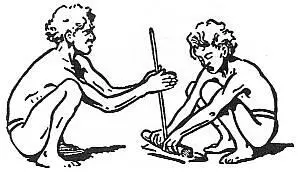
The Zulu boys light a fire by twirling a stick in softer wood.
The Red Indians of North America also have their method of fire-lighting, which is very much used by the Boy Scouts there.
Читать дальшеИнтервал:
Закладка:
Похожие книги на «Scouting for Boys»
Представляем Вашему вниманию похожие книги на «Scouting for Boys» списком для выбора. Мы отобрали схожую по названию и смыслу литературу в надежде предоставить читателям больше вариантов отыскать новые, интересные, ещё непрочитанные произведения.
Обсуждение, отзывы о книге «Scouting for Boys» и просто собственные мнения читателей. Оставьте ваши комментарии, напишите, что Вы думаете о произведении, его смысле или главных героях. Укажите что конкретно понравилось, а что нет, и почему Вы так считаете.

![Роберт Баден-Пауэлл - Искусство скаута-разведчика[Scouting for boys ; Искусство Разведки для мальчиков]](/books/70572/robert-baden-pauell-iskusstvo-skauta-thumb.webp)
